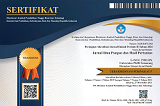THE EFFECT OF SOAKING SALTS CONCENTRATION TO CANDIED GARLIC (Sativum allium L.)
Abstract
Garlic has a bitter taste, which makes people reluctant to eat one whole garlic clove. The salt soaking technique used to reduce the bitter taste of the garlic, and the garlic processed into wet candied garlic, so it became more edible than not process. The process of candied garlic could preserve the durability level, which allows it to be stored longer at low temperatures. The research materials used were salt and sugar. The purpose of the research was to know the effect of salt concentration on reducing bitterness and the right concentration to reduce the bitter taste of garlic. This research used the RAK method, and DMRT (Duncan’s Multiple Range Test), and the samples of salt were 3%; 3.5%; 4%; 4.5%. The test included chemical tests (water content and total microbes) and organoleptic tests (taste, aroma, and texture). The water content of the product showed the result, which was not significantly different, and the total microbes test showed no microorganism was found or grew on the product. The organoleptic test of taste was obtained on 3.5% salt, with an average of 2.75% (likes), while the aroma and texture did not show a significant difference in the result. The aroma and texture data obtained on 2.90 (likes) and 2.40 (likes) with 3.5% salt.
Â
Keywords: Candied; Garlic; Salt; Soaking; Sugar.
Full Text:
PDFReferences
Aristawati, Anita Treisya. 2016. Penggunaan Daun Kemangi (Ocimum basilicum) dan Garam Dapur (NaCl) sebagai Bahan Pengawet pada Ikan Selar (Selaroides sp.). Jurnal Sains dan Teknologi Tasulako, 5(2):7-15
BPS. 2017. Statistika Tanaman Sayuran dan Buah-buahan Semusim. https://www.bps.go.id/ (Akses 26 Maret 2019)
Buntaran W, Astirin OP, Mahajoeno E. 2011. Pengaruh Konsentrasi Larutan Gula Terhadap Karakteristik Manisan Kering Tomat (Lycopersicum esculentum). Jurnal Bioteknologi, 8(1):1-9
Farizal, Jon. 2018. Uji Daya Hambat Ekstrak Bawang Putih (Allium sativum) terhadap Salmoenella typhi. Journal of Nursing and public Health, 6(2):46-49
Iciek, M., Kwiecien, I., Chwatko, G., Jezewicz M.S., Pachel, D.K., Rokita, H. 2012. The Effect of Garlic Derived Sulphur Compounds on Cell Poliferation, Caspase 3 Activity, Thiol Levels and Anaerobic Sulphur Metabolism in Human Hepatoblastoma. Cell Biochemistry and Function, 30:198-204.
Kartika, P.N dan Fithri, C.N. 2015. Studi Pembuatan Osmodehidrat Buah Nanas (Ananas comosus L. Merr): Kajian Konsentrasi Gula dalam Larutan Osmosis dan Lama Perendaman. Jurnal Pangan dan Agroindustri, 3(4):1345-1355.
Kementan RI Kementrian Pertanian Republik Indonesia. 2017. Proyek CF SKR: Pengembangan Bawang Putih di Temanggung dan Krisan di Tomohon.
Koswara, S. 1991. Kontrol Terhadap Reaksi Browning dalam Pengolahan Pangan. Makalah Pusat Antar Universitas Pangan dan Gizi. Institut Pertanian Bogor. Bogor.
Srihari, Endang dkk. 2015. Ekstrak Bawang Putih Bubuk dengan Menggunakan Proses Spray Drying. Jurnal Teknik Kimia, 9(2):62-68.
Wijaya, R. 2009. Penerapan Peraturan dan Praktek Keamanan Pangan Jajanan Anak Sekolah di Sekolah Dasar Kota dan Kabupaten Bogor. Skripsi. Institut Pertanian Bogor. Bogor.
DOI: https://doi.org/10.26877/jiphp.v3i2.4947
Refbacks
- There are currently no refbacks.
Copyright (c) 2020 Jurnal Ilmu Pangan dan Hasil Pertanian

This work is licensed under a Creative Commons Attribution-NonCommercial 4.0 International License.

Jurnal Ilmu Pangan dan Hasil Pertanian by Universitas PGRI Semarang is licensed under a Creative Commons Attribution-ShareAlike 4.0 International License.



